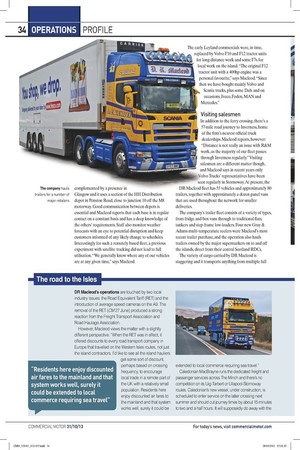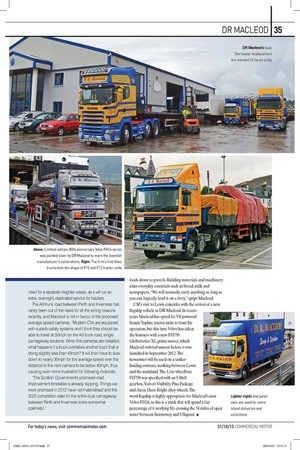e roa to t e s es
Page 27

Page 28

If you've noticed an error in this article please click here to report it so we can fix it.
DR Macleod's operations are touched by two local industry issues: the Road Equivalent Tariff (RET) and the introduction of average speed cameras on the A9. The removal of the RET (CM 27 June) produced a strong reaction from the Freight Transport Association and Road Haulage Association. However, Macleod views the matter with a slightly different perspective. "When the RET was in effect, it offered discounts to every road transport company in Europe that travelled on the Western Isles routes, not just the island contractors. I'd like to see all the island hauliers get some sort of discount, perhaps based on crossing frequency, to encourage local trade in a remote part of the UK with a relatively small population. Residents here enjoy discounted air fares to the mainland and that system works well, surely it could be
extended to local commerce requiring sea travel." Caledonian MacBrayne runs the dedicated freight and passenger services across The Minch and there's no competition on its Uig-Tarbert or Ullapool-Stornoway routes. Caledonian's new vessel, under construction, is scheduled to enter service on the latter crossing next summer and should cut journey times by about 15 minutes to two and a half hours. It will supposedly do away with the
need for a separate freighter vessel, as it will run an extra, overnight, dedicated service for hauliers.
The A9 trunk road between Perth and Inverness has rarely been out of the news for all the wrong reasons recently, and Macleod is not in favour of the proposed average speed cameras. "Modern CVs are equipped with superb safety systems and I think they should be able to travel at 50mph on the A9 trunk road, single carriageway sections. When the cameras are installed, what happens if a truck overtakes another truck that is doing slightly less than 40mph? It will then have to slow down to nearly 30mph for the average speed over the distance to the next camera to be below 40mph, thus causing even more frustration for following motorists.
"The Scottish Government's promised road improvement timetable is already slipping. Things we were promised in 2012 have not materialised and the 2025 completion date for the entire dual carriageway between Perth and Inverness looks somewhat optimistic."









































